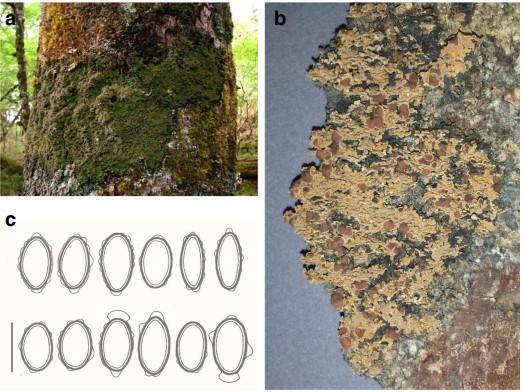Hispidopannaria hispidula (Nyl.) Elvebakk, S.G. Hong &C.H. Park, comb. nov.
MycoBank number: MB 837375; Index Fungorum number: IF 837375; Facesoffungi number: FoF 13340;
≡ Psoroma hispidulum Nyl. in Flora 38: 647 (1855) ≡ Pannaria hispidula (Nyl.) Hue in Bull. Soc. Bot. Fr. 48: 57 (1902).
Type: Chile: Arique in alta montana regione Myrtus Lumae, Feb. 1852, W. Lechler H-NYL 30816 lectotype!, lectotypified by Jørgensen (2003: 69), ill. at http://plants. jstor.org.; H-NYL 30815 isolectotype! ill. at http://plants. jstor.org; isolectotype PM!; W isolectotype!; four isolectotypes BM!), isolectotypifications made here (Fig. 2).
Description: Thallus of chloromorph 5–30 cm diam., corticolous, large-squamulose. Squamules geotropically arranged on a large and distinct blackish hypo−/prothallus. In peripheral parts numerous, tiny to 5 mm diam., discretely positioned directly on the hypothallus and more or less adpressed, in central parts of thalli, erect, imbricate, subdichothomously divided, forming a contiguous mat, 3–7 mm tall. Lobes 0.3–0.5 mm wide, 150–250 μm thick. Upper surface grayish when fresh and dry, dark salad-green when fresh and moist, gradually turning chestnut brown in old herbarium specimens, matt, distinctly hispid from hyaline erect hairs, 60–100 μm long, 5– 10 μm thick, with indistinct septae. Upper cortex 40–60 μm thick, hyaline, composed of paraplectenchymatous tissue, with small lumina (c. 5 μm) and thin walls (c. 2 μm), becoming thicker and more sclerenchymatic near the surface. Photobiont layer 50–80 μm thick, gradually intergrading to the medulla, with 6–13 × 8–16 μm large, globose/subglobose Trebouxia cells. Medulla c. 50 μm thick, pale, composed of laxly inter- woven hyphae, partly papillose. Lower cortex absent, but lower surface also hispid, with hairs up to 200 μm long. Cephalodia very common, small-foliose to small-fruticose, forming 1– 5 mm large rosettes inbetween chlorobiont squamules, hispid and basically similar to the latter, but lobes smaller and 0.1–0.3 mm broad. Cyanobacteria Nostoc, 4–6× 4–7 μm large, emerald green, sometimes grayish blue, subglobose to short- ellipsoid, often weakly angulose, arranged within 15–30 μm large glomeruli, but chain structures often distinct when liberated from their glomeruli.
Apothecia 1–3.5 mm wide, substipitate, laminal on the chlorobiont. Discs chestnut-brown on old specimens, flat to weakly convex. Thalline excipulum thin, 0.1–0.2 μm thick, weakly crenate, hispid. Epithecium light brown, c. 10 μm. Hymenium transparent, but strongly IKI+ blue, c. 70–90 μm thick. Paraphyses simple or weakly branched, densely developed and often dominating in sections, septate, weakly papillose and with swollen apices. Asci clavate, 15 × 70–90 μm, with 8 ascospores and a cap-like apical IKI + blue structure. Proper spores hyaline, non-septate, ellipsoid, 13–18 × 10– 12 μm. Perispores 15–21 × 11–14 μm, verruculose when im- mature, later smooth, except for large apical pulvinate extensions, up to 2.5 × 4 μm, and occasional pulvinate verrucae. Hypothecium light brown, c. 70 μm thick, IKI negative.Pycnidia scattered, marginal on chlorobiont squamules, forming brown verrucae 0.1–0.15 mm wide. Spermatia bacilliform, often weakly curved, 2–2.5 × 0.5 μm.
Chemistry: No compounds detected by TLC, and no visible melanins/pigments except in the apothecia.
Additional specimens studied (25). CHILE. XIV Región de los Ríos: Mafil, 300 m, 16 Aug. 1925, P. A. Hollermayer (BG; W 1927-384); La Unión, Llancacura, 22 Jan. 1969, M. Mahu 1626 (NY; SGO; UPS); Mahu s.n. (B 600166453; B 600157147; W 1976-09802); Valdivia, Collico, 13 Sept.1940, R. Santesson 8315 (S); Corral, Dec. 1905, R. Thaxter (B 102087; W 1935-1722); Lago Riñihue, Riñihue, 22 IX. 1940, R. Santesson 3526 (S); Curiñanco, March 7, 1948, B. Sparre 4753 (S). X Región del los Lagos: Parque Nacional Vicente Pérez Rosales. Lago Todos Los Santos. Puerto Manzano, slopes of Cordillera Derrumbe, 41° 12′ S, 72° 17′ W, 500–800 m. 11 Dec. 1986, B.J. Coppins 5013, D.J. Galloway, G. Guzmán & P.W. James (SGO; BM; CHR); Prov. Osorno, forest in valley of Río Nauto near road to Refugio Antillanca, between Laguna El Encanto and Lago Toro, 2400 ft., 14 Sept 1969, H. Imshaug 43,097 (SGO; W 1994-03668; W 1994-091844); Llanquihue Lake, 150 m, 1965, G. Follmann 16,748 (B 600192138); XI Región de Aisén: Taitao Peninsula, Península de Sisquelán, 30 m inland, 1 Feb. 1990, G. Hilsden & S. Brown 10,431 (BG); Port Grappeler (Patagonia), 1868, R.O. Cunningham (BM); Gray Harbor, 30 Nov. 1868, R.O. Cunningham (BM); Isla Berta (near Tortel), 47° 49′ 22.5″ S, 73° 47′ 50.7″, 2 Marzo 2003, J. Cuvertino 60 (SGO 149825); J. Cuvertino 58 (SGO 149729); c. 10 km E of Laguna Cofré, 46° 08.147′ S, 72° 35.600′ W, 350 m, 27 Nov. 2007, A. Elvebakk 07:038 (TROM; H); c. 5 km W of Laguna Cofré, 46° 11.259′ S, 72° 45.598′ W, 580 m, 5 Dec. 2007, A. Elvebakk 07:306 (TROM); 07:309 (TROM).

Fig. 2 Hispidopannaria hispidula. a The specimen Elvebakk 07:309, photographed in the field when moist. The specimen to the left measures 30 cm across. b The specimen Mahu s.n., B 60 0166453.
